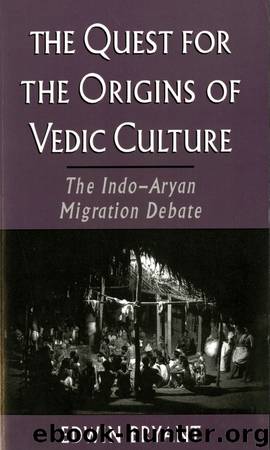The Quest for the Origins of Vedic Culture by Bryant Edwin;

Author:Bryant, Edwin;
Language: eng
Format: epub
ISBN: 9780195169478
Publisher: Oxford University Press USA - OSO
Published: 2015-03-03T10:11:03+00:00
10
Aryans in the Archaeological Record
The Evidence outside the Subcontinent
The previous chapters have outlined the assumptions underlying the linguistic evidence that is generally accepted as decisive in eliminating South Asia as a potential origin for the Indo-European languages and holding that the Indo-Aryan languages must have entered the subcontinent from the outside. The question has been raised regarding the extent to which the various linguistic methods are capable of determining whether the language flow of Indo-European immediately after the dissolution of the protolanguage was from north to south or south to north, or from west to east or vice versa. And the observation has been made that while the Vedic texts themselves can be used to demonstrate an escalating movement into the eastern and southern parts of India, they do not provide unambiguous evidence for a movement into the Northwest itself.
The other major discipline that has been an indispensable part of the quest for the Indo-Europeans is, of course, archaeology. While Nichols’s linguistic model could be adopted or adapted somewhat to account for an Indo-European language spread from an eastern point of origin, there is no archaeological evidence that can be readily invoked to substantiate it. Archaeologists have not found any outgoing material culture correlatable with the Indo-Europeans that can be traced as flowing from the east to the west in a chronologically and geographically acceptable fashion. Accordingly, the discussion in this section must be restricted to examining the proposals of those scholars who have attempted to use the archaeological record to trace the incoming migrations of the Indo-Aryans. This limitation is not likely to escape the attention of the detractors of the Indigenous Aryan position: “The archaeological lack of evidence for inward migration often cited by proponents of the ‘Out-of-India’ hypothesis would have to be balanced with the lack of archaeological evidence for the presumably much more massive and prolonged outward migration required under this hypothesis” (Hock 1999a 16).
Although it is debatable whether an outward migration would need to be much more massive than an inward one, the point holds good. Indeed, as we have seen, Nichols’s homeland was a priori subjected to this criticism before her thesis had even been published. A parallel archaeological lacuna has been one of the principal objections raised against the central Anatolian homeland. As Gamkrelidze and Ivanov (1983a) themselves hasten to point out in anticipation of their detractors’ reactions: “It should be noted at the outset that the original area of distribution for the Proto-Indo-European language in the fourth-fifth millennia B.C. does not have an archaeological culture which might be identified in any explicit way with Proto-Indo-European” (35). As we have seen, Renfrew, (1987) an archaeologist defending more or less adjacent geographic contours as these linguists, does provide a material culture, but one in a significantly different temporal bracket. However, in so doing, he completely undermines the traditional criteria used in searching for the Indo-Europeans in the archaeological record. Since his Proto-Indo-European is a sedentary agriculturist to be traced paleobotanically via the spread of agriculture, he bypasses the traditionally almost exclusive focus on grave goods and pottery styles.
Download
This site does not store any files on its server. We only index and link to content provided by other sites. Please contact the content providers to delete copyright contents if any and email us, we'll remove relevant links or contents immediately.
| Africa | Americas |
| Arctic & Antarctica | Asia |
| Australia & Oceania | Europe |
| Middle East | Russia |
| United States | World |
| Ancient Civilizations | Military |
| Historical Study & Educational Resources |
The Daily Stoic by Holiday Ryan & Hanselman Stephen(3112)
The Fate of Rome: Climate, Disease, and the End of an Empire (The Princeton History of the Ancient World) by Kyle Harper(2878)
People of the Earth: An Introduction to World Prehistory by Dr. Brian Fagan & Nadia Durrani(2620)
Ancient Worlds by Michael Scott(2496)
Babylon's Ark by Lawrence Anthony(2434)
Foreign Devils on the Silk Road: The Search for the Lost Treasures of Central Asia by Peter Hopkirk(2389)
The Daily Stoic by Ryan Holiday & Stephen Hanselman(2349)
India's Ancient Past by R.S. Sharma(2303)
MOSES THE EGYPTIAN by Jan Assmann(2278)
The Complete Dead Sea Scrolls in English (7th Edition) (Penguin Classics) by Geza Vermes(2139)
Lost Technologies of Ancient Egypt by Christopher Dunn(2113)
The Earth Chronicles Handbook by Zecharia Sitchin(2103)
24 Hours in Ancient Rome by Philip Matyszak(1976)
Alexander the Great by Philip Freeman(1965)
Aztec by Gary Jennings(1880)
The Nine Waves of Creation by Carl Johan Calleman(1785)
Curse Tablets and Binding Spells from the Ancient World by Gager John G.;(1769)
Before Atlantis by Frank Joseph(1742)
Earthmare: The Lost Book of Wars by Cergat(1717)
